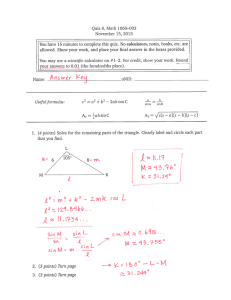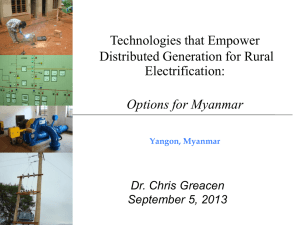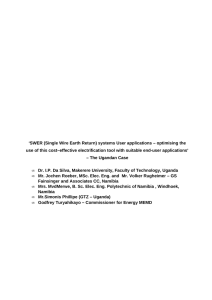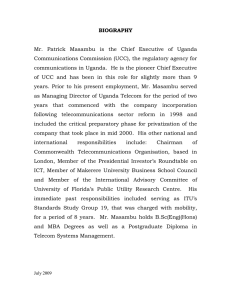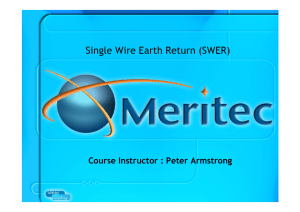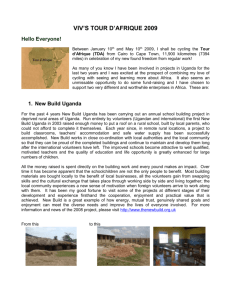THE USE OF SINGLE WIRE EARTH RETURN (SWER) AS A
advertisement
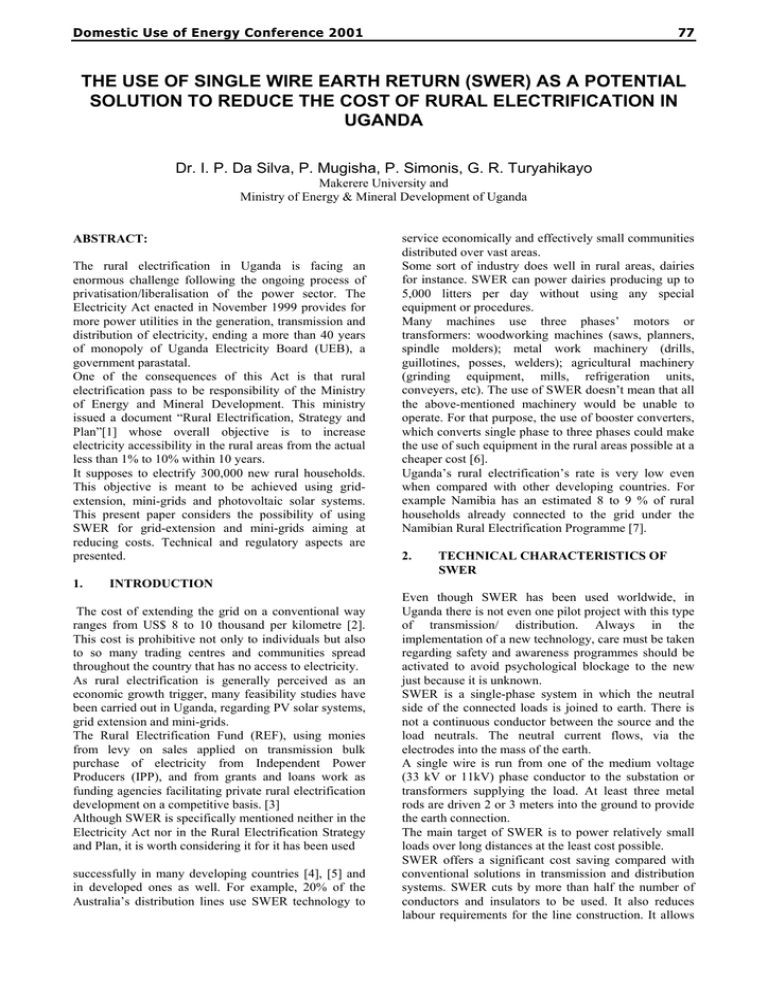
Domestic Use of Energy Conference 2001 77 THE USE OF SINGLE WIRE EARTH RETURN (SWER) AS A POTENTIAL SOLUTION TO REDUCE THE COST OF RURAL ELECTRIFICATION IN UGANDA Dr. I. P. Da Silva, P. Mugisha, P. Simonis, G. R. Turyahikayo Makerere University and Ministry of Energy & Mineral Development of Uganda ABSTRACT: The rural electrification in Uganda is facing an enormous challenge following the ongoing process of privatisation/liberalisation of the power sector. The Electricity Act enacted in November 1999 provides for more power utilities in the generation, transmission and distribution of electricity, ending a more than 40 years of monopoly of Uganda Electricity Board (UEB), a government parastatal. One of the consequences of this Act is that rural electrification pass to be responsibility of the Ministry of Energy and Mineral Development. This ministry issued a document “Rural Electrification, Strategy and Plan”[1] whose overall objective is to increase electricity accessibility in the rural areas from the actual less than 1% to 10% within 10 years. It supposes to electrify 300,000 new rural households. This objective is meant to be achieved using gridextension, mini-grids and photovoltaic solar systems. This present paper considers the possibility of using SWER for grid-extension and mini-grids aiming at reducing costs. Technical and regulatory aspects are presented. 1. service economically and effectively small communities distributed over vast areas. Some sort of industry does well in rural areas, dairies for instance. SWER can power dairies producing up to 5,000 litters per day without using any special equipment or procedures. Many machines use three phases’ motors or transformers: woodworking machines (saws, planners, spindle molders); metal work machinery (drills, guillotines, posses, welders); agricultural machinery (grinding equipment, mills, refrigeration units, conveyers, etc). The use of SWER doesn’t mean that all the above-mentioned machinery would be unable to operate. For that purpose, the use of booster converters, which converts single phase to three phases could make the use of such equipment in the rural areas possible at a cheaper cost [6]. Uganda’s rural electrification’s rate is very low even when compared with other developing countries. For example Namibia has an estimated 8 to 9 % of rural households already connected to the grid under the Namibian Rural Electrification Programme [7]. 2. TECHNICAL CHARACTERISTICS OF SWER INTRODUCTION The cost of extending the grid on a conventional way ranges from US$ 8 to 10 thousand per kilometre [2]. This cost is prohibitive not only to individuals but also to so many trading centres and communities spread throughout the country that has no access to electricity. As rural electrification is generally perceived as an economic growth trigger, many feasibility studies have been carried out in Uganda, regarding PV solar systems, grid extension and mini-grids. The Rural Electrification Fund (REF), using monies from levy on sales applied on transmission bulk purchase of electricity from Independent Power Producers (IPP), and from grants and loans work as funding agencies facilitating private rural electrification development on a competitive basis. [3] Although SWER is specifically mentioned neither in the Electricity Act nor in the Rural Electrification Strategy and Plan, it is worth considering it for it has been used successfully in many developing countries [4], [5] and in developed ones as well. For example, 20% of the Australia’s distribution lines use SWER technology to Even though SWER has been used worldwide, in Uganda there is not even one pilot project with this type of transmission/ distribution. Always in the implementation of a new technology, care must be taken regarding safety and awareness programmes should be activated to avoid psychological blockage to the new just because it is unknown. SWER is a single-phase system in which the neutral side of the connected loads is joined to earth. There is not a continuous conductor between the source and the load neutrals. The neutral current flows, via the electrodes into the mass of the earth. A single wire is run from one of the medium voltage (33 kV or 11kV) phase conductor to the substation or transformers supplying the load. At least three metal rods are driven 2 or 3 meters into the ground to provide the earth connection. The main target of SWER is to power relatively small loads over long distances at the least cost possible. SWER offers a significant cost saving compared with conventional solutions in transmission and distribution systems. SWER cuts by more than half the number of conductors and insulators to be used. It also reduces labour requirements for the line construction. It allows Domestic Use of Energy Conference 2001 78 for lighter poles and wider spacing to be used as conductor clashing can be disregarded. 2.1 r = resistivity in Ω/m L = length of the rod [m] a = radius of the rod [m] ISOLATION SUBSTATION Isolation substation is the main element of the SWER system and is a must when regarding safety. Without SWER isolation transformers, the return current would flow back to the main zone transformer resulting in high voltages being applied to equipment. SWER requires an under-strung earth wire for safety reasons whenever the line comes close to a village, children play-grounds, sport facilities, trading centres, churches, etc. All equipment and cubicles within the substation yard must have their casings carefully earthed to avoid unduly step voltage and touch voltage. The substation shall be covered with gravel and fenced. 2.2 where: Figure one shows a grounding design, which can be used as a general solution to earth transformers, cases and loads in most of the SWER in Uganda. Concrete Cover To transformer ground terminal Insulated Earth SWER TRANSFORMERS Earthenware pipe Manufacturers, such ALSTOM, produce SWER transformers from 16 kVA to 25 kVA. Those are special isolation transformers. Though these are small transformers, the SWER transformers can be manufactured in values up to 400 kVA, 33 kV primary and 19 kV secondary with an off circuit top switch on primary voltage. 2.3 Four mesh grid EARTHING The effectiveness in the design of SWER is basically depending on the proper design of the earthing scheme. The ground connection must be implemented at each distribution transformer and the proposed sub-station(s). The earth connection shall have a resistance no greater than 5 ohms. Another concern regarding earthing schemes is that is must be well sealed to avoid thefts. In Uganda, a pilot project set up in the Tororo region failed due to people stealing the cooper rods from the transformers’ earthing. Figure 1 – Schematic Earthing 4. ADVANTAGES AND LIMITATIONS OF SWER 4.1 ADVANTAGES OF SWER SWER technology offers a significant cost saving compared to conventional solutions in certain applications. The main advantages are: • • 3. EARTH RESISTIVITY The SWER can be implemented only in regions where the earth resistivity falls below 1000 ohms per meter. Beyond this limit a conventional set-up is advisable. Below the 1000 ohm per meter limit earth resistivity can go as low as 5 ohms per meter. It also varies depending on the depth. Except from the rocky areas of northwest and west the soil of Uganda presents good resistivity for SWER falling well below the 1000 ohms per meter limit. The formula below gives the ground resistance (R) for a single rod in ohms per meter, and is used to design earth-grounding schemes: r 4L R= ln ( - 1) [Ω/m] (1) 2πL a Copper rod • • • • The system reduces the number of conductors and insulators by more than half than those required in a three-phase system; It allows for higher poles and a wider spacing due to lighter conductors, moreover reduced in numbers; It reduces labour requirements for line construction as a result of the advantage mentioned above; The system can also be used to supply a booster (phase-converter), which converts the singlephase into a three-phase system. In this case the single wire substitutes the four wires standard three phase standard system permitting greater saves to be made; SWER can also be upgraded with the introduction of additional isolation transformer as the loading increases, allowing phased incrementation of infrastructure and delayed capital investment; The use of shorter and lighter poles aids construction in remote areas and difficult terrain. Domestic Use of Energy Conference 2001 79 Besides the visual impact is much less than the conventional system; A downed conductor lying on the ground from the load side is de-energised, unlike a threephase one where the other two phases will make the conductor downed energised; SWER span lengths are generally longer implying that a downed cable will result in a longer length in contact with the ground; and The probability of failure of a line is in some way proportional to the number of conductors and therefore a SWER line has an advantage over a three-phase line. The earth-connection shall be of resistance not greater than 5 ohms to earth and shall be so installed as to prevent danger from voltage gradients at ground level. Step and touch potential shall be in accordance with the Ugandan Electrical Code of Practice for Power Systems Earthing. 4.2 LIMITATIONS AND CONSTRAINTS OF SWER • It is limited to areas where the earth resistivity is within the 1000 ohms per meter limit; The voltage drops as load increases more than in a conventional system; Besides of the cable/transformer limits, the power to be transferred is limited by the magnitude of the current on the earthing system; and The interference with telephone lines due to earth potential rise (EPR) makes it mandatory to have large distances between SWER lines and communication lines (see Table 1). The overload protection of earth-return circuits shall be such as to reduce to a practicable minimum the risk of a conductor remaining alive after it has fallen owing to breakage or otherwise. • • • • • • 5. PROPOSED STANDARD FOR SWER As Uganda does not have yet any functional SWER, a technical standard regarding safety should be issued to make sure that SWER systems installed wont be the cause of haphazard. The points mentioned below should be present in the said standard and are based on the New Zealand standards for SWER [12]. 5.1 TRANSFORMERS Single wire earth return systems are to be supplied from double-wounded transformers (isolating transformers). These circuits are to supply only doublewound step-down transformer having either three-wire 280/240 V or two-wire 240 V secondary operating as for the multiple-earthed-neutral systems. 5.2 5.3 LOAD CURRENT The maximum permissible load current in any earthreturn circuit shall be 10 amps. 5.4 5.5 PROTECTION SEPARATION FROM OTHER SERVICES AND PLANTS The minimum separation between any conductor of an earth—return circuit and any open wire overhead communication line shall be 80 meters, except at crossings. No earth-return circuit conductor shall be erected parallel to any open wire overhead communication line so that the normal induced longitudinal voltage in the communication line exceeds 2 volts rms. The minimum separation between any conductor of an earth-return circuit parallel with any open wire communication circuit shall be in accordance with Table 1. Table 1: Separation between SWER and other communication circuits in meters Length of parallel communication circuits (km) Min. Average Separation from Comm. Circuits p=5 p=47 8 220 640 16 300 1000 24 400 1230 32 480 1430 40 540 1600 p= earth resistivity in ohms/meter p=200 1350 2000 2430 2900 3240 p=1000 3060 4570 5790 6860 7460 EARTHING ARRANGEMENTS 6. Isolating and step-down transformers windings connected to SWER circuits shall be fully insulated from their tanks. The connection with earth shall be made externally by means of duplicate conductors of stranded copper each having a cross section of not less than 16 mm2. The duplicated conductors shall be installed unbroken and without joint, using different routes, and shall have separated and independent attachment to the earth electrode. ECONOMICAL CONSIDERATIONS Table 2 shows a comparison between a SWER system and a conventional 33kV system design to serve Sembabule, a rural district of Uganda[13]. Line equipment is fuses and switches; substations include ground-mounted equipment and gear; transformers include power and distribution ones; grounding also includes pole-mounted equipment and substation grounding. Finally the overhead used is 40% of the capital outlay. Domestic Use of Energy Conference 2001 Table 2: Expenditure comparison between SWER and a three-phase 33kV system 80 [4] A. Louw; E. Naude: “Antioch: A pioneer SWER electrification Project” in Proceedings of New Technologies for Rural Electrification Seminar, Johannesburg, March 1998 [5] Hardie R. : “ Alternative Technologies for Rural Electrification” in Proceedings of Aberdale Power Cable Seminar, Harare, 1998 http://www.eurotech.co.nz/converters.html [6] Afrane-Okese Y.: “Socio-Economic Impact Assessment of Rural Grid Electrification in Namibia” in Proceedings of DUEE 1999, Cape Town, 1999, pg 53 Table 2 shows that an almost 29 % savings can be achieved using SWER in order to serve a whole community of over 200,000 inhabitants. The case of providing electricity to small rural communities such as the ones the RE Strategy and Plan is aiming at can bring this savings up to 40 %. [7] District Water Development and Plan, UNICEF – SW, Integrated Project, December, 1991, Volume III [8] Eaton, J.: Electric Power Systems, Prentice-Hall, chapter 13, pg 327-349. 7. [9] Starr, A. T.: General Transmission and Utilization of Electric Energy, chapter 14, pg. 416 [10] Code of Conditions Governing SWER Systems in New Zealand [11] Standards on Step and Touch Voltages for Uganda. [12] Ggonzaga Sylvestre: “Affordable Rural Electrification: Sembabule District – A case Study”Final year project, Makerere University, June, 1999. [Unpublished]. 9. AUTHORS Item Lines Line Equipment Substations Transformers Grounding Overheads Total Savings Expenditure (US$) SWER Conventional 494,200 889,700 7,000 13,000 95,000 140,000 173,400 170,100 136,000 58,800 362,200 508,700 1,267,800 1,780,300 512,500 (28,8%) CONCLUSIONS Technical SWER is recognized worldwide as a sure and affordable way of providing energy to sparsely populated areas. The studies regarding Uganda conditions showed that considerable savings could be achieved. The previous experience in Tororo district failed due to theft and provision should be made to avoid that happening again. We suggest that this technology should be taken into consideration in the implementation of the RE Strategy and Plan and be considered in the Word Bank “Energy for Rural Transformation” project for Uganda as well. One or more pilot projects should be implemented to access practicability within local environment. 8. REFERENCES [1] Rural Electrification Strategy and Plan, Ministry of Energy and Mineral Development, draft, November 2000. [2] Da Silva, I.P.; Mugisha P.; Turyahikayo G.R.: “Electric Power Supply to Households in Uganda Using Hybrid Wind and Solar PV generation” in Proceedings of Domestic Use of Electrical Energy Conference, Cape Town, March-April 1999, pg 210 [3] Da Silva, I.P.; Mugisha P.; Simonis P.; Turyahikayo G.R.: “The reform of the Electric Sector and its impact on the development of the rural areas in Uganda” in Proceedings of Domestic Use of Energy Conference, Cape Town, April 2000, pg 106 Izael Pereira da Silva holds a Principal Author: Ph.D. in Engineering from the University of São Paulo (Brazil). At present is a Lecturer at Makerere University and is working in some projects related with Solar and Wind Power generation. His address is: P O Box 21706, Kampala – Uganda Telephone 256 41 540415 E-mail: bugala@afsat.com Patrick Mugisha holds a Master of Co-author: Science from University of Oldenburg (West Germany). At present is a lecturer at Makerere University and works as a consultant on electrical and energy matters under TECO (Technology Consults, Faculty of Technology, Makerere University). His address is: Makerere University P O Box 7062, Kampala – Uganda Telephone 256 41 543594 Domestic Use of Energy Conference 2001 G.R. Turyahikayo is specialised in Co-author: Energy Analysis and is the Commissioner for Energy under the Ministry of Energy and Mineral Development of the Government of Uganda. His address is: P O Box 7270, Kampala – Uganda Telephone 256 41 349010, Fax 256 41 230220 E-mail: grt.uppre@infocom.co.ug Philippe Simonis is energy advisor Co-author: and co-ordinates the Energy Advisory Project under the Ministry of Energy and Mineral Development of the Government of Uganda, supported by the German Development Co-operation (GTZ). His address is: P.O.Box 10346, Kampala – Uganda Tel/Fax 256 41 234165 E-mail:simonis@swiftuganda.com 81
